WHO WAS QASEM SOLEIMANI
Qasem Soleimani (Persian: قاسم سلیمانی, pronounced [ɢɒːˌsem(e) solejmɒːˈniː]; 11 March 1957 – 3 January 2020), also transliterated as Qassem Suleimani or Qassim Soleimani, was an Iranian Major General in the Islamic Revolutionary Guard Corps (IRGC) and, from 1998 until his death in 2020, commander of its Quds Force, a division primarily responsible for extraterritorial military and clandestine operations. He had Shadow Commander as his nickname. [21]
Soleimani began his military career at the start of the Iran–Iraq War during the 1980s, eventually commanding the 41st Division. He was later involved in extraterritorial operations, providing military assistance to Hezbollah in Lebanon. In 2012, Soleimani helped bolster the government of Bashar al-Assad, a key Iranian ally, during Iran's operations in the Syrian Civil War and helped to plan the Russian military intervention in Syria.[22] Soleimani oversaw the Kurdish and Shia militia forces in Iraq, and assisted the Iraqi forces that advanced against ISIL in 2014–2015.[23][24] Soleimani was one of the first to support Kurdish forces, providing them with arms.[25][26] He maintained a low profile during most of his career. Soleimani was widely popular among Iranians, where his supporters viewed him as a "selfless hero fighting Iran's enemies."[27][28]
Solemaini was personally sanctioned by the United Nations and the European Union,[29][30][31] and was designated as a terrorist by the United States.[32][33][34]
Soleimani was killed[35][36][37][38] in a targeted U.S. drone strike on 3 January 2020 in Baghdad, which was approved by President Donald Trump. A multi-city funeral was held in Iraq and Iran for the killed general and other casualties. Hours after Soleimani's burial on 7 January 2020, the Iranian military launched missiles against U.S. bases in Iraq; no American or Iraqi lives were lost in the attack.[39]
Early life
Soleimani was born on 11 March 1957, in the village of Qanat-e Malek, Kerman Province.[40][41][42][43][note 1] After he finished school, he moved to the city of Kerman and worked on a construction site[41][43] to help repay his father's agricultural debts. In 1975, he began working as a contractor for the Kerman Water Organization.[45][41][46] When not at work, he spent his time with weight training in local gyms, or attending the sermons of Hojjat Kamyab, a preacher and a protege of Ali Khamenei, who according to Soleimani spurred him to "revolutionary activities".[2][47]
Military career

Soleimani joined the Revolutionary Guard (IRGC) in 1979 following the Iranian Revolution, which saw the Shah fall and Ayatollah Khomeini take power. Reportedly, his training was minimal, but he advanced rapidly. Early in his career as a guardsman, he was stationed in northwestern Iran, and participated in the suppression of a Kurdish separatist uprising in West Azerbaijan Province.[2]
| “ | I entered the [Iran-Iraq war] on a fifteen-day mission, and ended up staying until the end ... We were all young and wanted to serve the revolution. | ” |
| — Quoted in Dexter Filkins (30 September 2013), "The Shadow Commander", The New Yorker | ||
On 22 September 1980, when Saddam Hussein launched an invasion of Iran, setting off the Iran–Iraq War (1980–1988), Soleimani joined the battlefield serving as the leader of a military company, consisting of men from Kerman whom he assembled and trained.[48] He quickly earned a reputation for bravery,[49] and rose through the ranks because of his role in successful operations to retake the lands Iraq had occupied, and eventually became the commander of the 41st Tharallah Division while still in his 20s, participating in most major operations. He was mostly stationed at the southern front.[48][50] He was seriously injured in Operation Tariq-ol-Qods. In a 1990 interview, he mentioned Operation Fath-ol-Mobin as "the best" operation he participated in and "very memorable", due to its difficulties yet positive outcome.[51] He was also engaged in leading and organizing irregular warfare missions deep inside Iraq by the Ramadan Headquarters.[clarification needed] It was at this point that Soleimani established relations with Kurdish Iraqi leaders and the Shia Badr Organization, both opposed to Iraq's Saddam Hussein.[48]
On 17 July 1985, Soleimani opposed the IRGC leadership's plan to deploy forces to two islands in western Arvand Rud, on the Shatt al-Arab River.[52][why?]
After the war, during the 1990s, he was an IRGC commander in Kerman Province.[50] In this region, which is relatively close to Afghanistan, Afghan-grown opium travels to Turkey and on to Europe.[citation needed] Soleimani's military experience helped him earn a reputation as a successful fighter against drug trafficking.[2]
During the 1999 student revolt in Tehran, Soleimani was one of the IRGC officers who signed a letter to President Mohammad Khatami. The letter stated that if Khatami did not crush the student rebellion, the military would and it might also launch a coup against Khatami.[2][53]
Command of Quds Force

The exact date of his appointment as commander of the IRGC's Quds Force is not clear, but Ali Alfoneh cites it as between 10 September 1997 and 21 March 1998.[46] He was considered one of the possible successors to the post of commander of the IRGC, when General Yahya Rahim Safavi left this post in 2007. In 2008, he led a group of Iranian investigators looking into the death of Imad Mughniyah. Soleimani helped arrange a ceasefire between the Iraqi Army and Mahdi Army in March 2008.[54]
Following the September 11 attacks in 2001, senior U.S. State Department official Ryan Crocker flew to Geneva to meet with Iranian diplomats who were under the direction of Soleimani with the purpose of collaborating to destroy the Taliban.[2] This collaboration was instrumental in defining the targets of bombing operations in Afghanistan and in capturing key Al-Qaeda operatives, but abruptly ended in January 2002, when President George W. Bush named Iran as part of the "Axis of evil" in his State of the Union address.[2]
Soleimani strengthened the relationship between Quds Force and Hezbollah upon his appointment, and supported the latter by sending in operatives to retake southern Lebanon.[2] In an interview aired in October 2019, he said he was in Lebanon during the 2006 Israel–Hezbollah War to oversee the conflict.[55]
In 2009, The Economist stated based on a leaked report that Christopher R. Hill and General Raymond T. Odierno (America's two most senior officials in Baghdad at the time) met with Soleimani in the office of Iraq's president, Jalal Talabani, but withdrew the story after Hill and Odierno denied the occurrence of the meeting.[56][57][58]
On 24 January 2011, Soleimani was promoted to Major General by Supreme Leader Ali Khamenei.[50][59] Khamenei was described as having a close relationship with him, calling Soleimani a "living martyr" and helping him financially.[2]
Soleimani was described by an ex-CIA operative as "the single most powerful operative in the Middle East today" and the principal military strategist and tactician in Iran's effort to combat Western influence and promote the expansion of Shiite and Iranian influence throughout the Middle East.[2] In Iraq, as the commander of the Quds Force, he was believed to have strongly influenced the organization of the Iraqi government, notably supporting the election of previous Iraqi Prime Minister Nuri Al-Maliki.[2][60]
Syrian Civil War
| “ | We're not like the Americans. We don't abandon our friends. | ” |
| — Attributed to Soleimani by a former Iraqi leader, referring to Syria. Quoted in Dexter Filkins (30 September 2013). "The Shadow Commander". The New Yorker. | ||
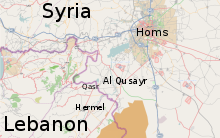
According to several sources, including Riad Hijab, a former Syrian premier who defected in August 2012, Soleimani was one of the staunchest supporters of the Syrian government of Bashar al-Assad in the Syrian Civil War.[2][60] In the later half of 2012, Soleimani assumed personal control of the Iranian intervention in the Syrian Civil War, when the Iranians became deeply concerned about the Assad government's lack of ability to fight the opposition, and the fallout to the Islamic Republic if the Syrian government fell. He reportedly coordinated the war from a base in Damascus at which a Lebanese Hezbollah commander and an Iraqi Shiite militia coordinator were mobilized, in addition to Syrian and Iranian officers. Under Soleimani the command "coordinated attacks, trained militias, and set up an elaborate system to monitor rebel communications". According to a Middle Eastern security official Dexter Filkins talked to, thousands of Quds Force and Iraqi Shiite militiamen in Syria were "spread out across the entire country".[2] The retaking of Qusayr in May 2013 from rebel forces and Al-Nusra Front[61] was, according to John Maguire, a former CIA officer in Iraq, "orchestrated" by Soleimani.[2]
Brigadier General Hossein Hamadani, the Basij's former deputy commander, helped to run irregular militias that Soleimani hoped would continue the fight if Assad fell.[2] Soleimani helped establish the National Defence Forces (NDF) in 2013 which would formalise the coalition of pro-Assad groups.[62]
Soleimani was much credited in Syria for the strategy that assisted President Bashar al-Assad in finally repulsing rebel forces and recapturing key cities and towns.[63] He was involved in the training of government-allied militias and the coordination of decisive military offensives.[2] The sighting of Iranian UAVs in Syria strongly suggested that his command, the Quds Force, was involved in the civil war.[2]
In a visit to the Lebanese capital Beirut on 29 January 2015, Soleimani laid wreaths at the graves of the slain Hezbollah members, including Jihad Mughniyah, which strengthened suspicions about a collaboration between Hezbollah and the Quds Force.[64]
Orchestration of military escalation in 2015
In 2015, Soleimani began gathering support from various sources to combat the newly resurgent ISIL and rebel groups which had both successfully taken large swaths of territory from Assad's forces. He was reportedly the main architect of the joint intervention involving Russia as a new partner with Assad and Hezbollah.[65][66][67][68]
According to Reuters, at a meeting in Moscow in July, Soleimani unfurled a map of Syria to explain to his Russian hosts how a series of defeats for President Bashar al-Assad could be turned into victory – with Russia's help. Qasem Soleimani's visit to Moscow was the first step in planning for a Russian military intervention that has reshaped the Syrian war and forged a new Iran–Russia alliance in support of the Syrian (and Iraqi) governments. Iran's supreme leader, Ali Khamenei also sent a senior envoy to Moscow to meet President Vladimir Putin. "Putin reportedly told [a senior Iranian envoy] 'Okay we will intervene. Send Qassem Soleimani.'" General Soleimani went to explain the map of the theatre and coordinate the strategic escalation of military forces in Syria.[67]
Operations in Aleppo
Soleimani had a decisive impact on the theater of operations, which led to a strong advance in southern Aleppo with the government and allied forces re-capturing two military bases and dozens of towns and villages in a matter of weeks. There was also a series of major advances towards Kuweiris air-base to the north-east.[75] By mid-November, the Syrian army and its allies had gained ground in southern areas of Aleppo Governorate, capturing numerous rebel strongholds. Soleimani was reported to have personally led the drive deep into the southern Aleppo countryside where many towns and villages fell into government hands. He reportedly commanded the Syrian Arab Army's 4th Mechanized Division, Hezbollah, Harakat Al-Nujaba (Iraqi), Kata'ib Hezbollah (Iraqi), Liwaa Abu Fadl Al-Abbas (Iraqi), and Firqa Fatayyemoun (Afghan/Iranian volunteers).[76]
In early February 2016, backed by Russian and Syrian air force airstrikes, the 4th Mechanized Division – in close coordination with Hezbollah, the National Defense Forces (NDF), Kata'eb Hezbollah, and Harakat Al-Nujaba – launched an offensive in Aleppo Governorate's northern countryside,[77] which eventually broke the three-year siege of Nubl and Al-Zahraa and cut off the rebels' main supply route from Turkey. According to a senior, non-Syrian security source close to Damascus, Iranian fighters played a crucial role in the conflict. "Qassem Soleimani is there in the same area", he said.[78] In December 2016, new photos emerged of Soleimani at the Citadel of Aleppo, though the exact date of the photos is unknown.[79][80]
In late March 2017, Soleimani was seen in the northern Hama Governorate countryside in Syria, reportedly aiding Major General Suheil al-Hassan to repel a major rebel offensive.[18]
War against ISIL in Iraq

Soleimani played a key role in Iran's fight against ISIL in Iraq. He is described as the "linchpin" bringing together Kurdish and Shia forces to fight ISIS, overseeing joint operations conducted by the two groups.[23]
In 2014, Qasem Soleimani was in the Iraqi city of Amirli, to work with Iraqi forces to push back ISIL militants.[24][82] The Los Angeles Times reported that Amirli was the first town to successfully withstand an ISIL invasion, and was secured thanks to "an unusual partnership of Iraqi and Kurdish soldiers, Iranian-backed Shiite militias and U.S. warplanes". The U.S. acted as a force multiplier for a number of Iranian-backed armed groups – at the same time that[clarification needed] was present on the battlefield.[83][84]
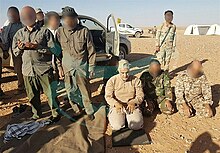
A senior Iraqi official told the BBC that when the city of Mosul fell, the rapid reaction of Iran, rather than American bombing, was what prevented a more widespread collapse.[12] Qasem Soleimani also seems to have been instrumental in planning the operation to relieve Amirli in Saladin Governorate, where ISIL had laid siege to an important city.[81] In fact, the Quds force operatives under Soleimani's command seem to have been deeply involved with not only the Iraqi army and Shi'ite militias but also the Kurdish in the Battle of Amirli,[85] not only providing liaisons for intelligence-sharing but also the supply of arms and munitions in addition to "providing expertise".[86]
In the operation to liberate Jurf Al Sakhar, he was reportedly "present on the battlefield". Some Shia militia commanders described Soleimani as "fearless" – one pointing out that the Iranian general never wears a flak jacket, even on the front lines.[87]
In November 2014, Shi'ite and Kurdish forces under Soleimani's command pushed ISIL out of Iraqi villages of Jalawla and Saadia in the Diyala Governorate.[23]
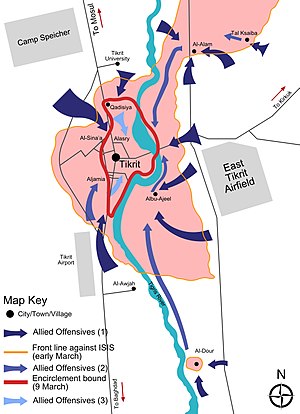
Soleimani played an integral role in the organisation and planning of the crucial operation to retake the city of Tikrit in Iraq from ISIL. The city of Tikrit rests on the left bank of the Tigris river and is the largest and most important city between Baghdad and Mosul, giving it a high strategic value. The city fell to ISIL during 2014 when ISIL made immense gains in northern and central Iraq. After its capture, ISIL's massacre at Camp Speicher led to 1,600 to 1,700 deaths of Iraqi Army cadets and soldiers. After months of careful preparation and intelligence gathering an offensive to encircle and capture Tikrit was launched in early March 2015.[89]
In 2016, photos published by a Popular Mobilization Forces (PMF) source showed Soleimani attending a meeting of PMF commanders in Iraq to discuss the Battle of Fallujah.[90]
CIA chief Mike Pompeo said that he sent Soleimani and other Iranian leaders a letter holding them responsible for any attacks on U.S. interests by forces under their control. According to Mohammad Mohammadi Golpayegani, a senior aide for Iran's supreme leader, Soleimani ignored the letter when it was handed over to him during the Abu Kamal offensive against ISIL, saying "I will not take your letter nor read it and I have nothing to say to these people."[91][92]
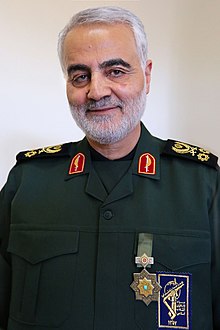
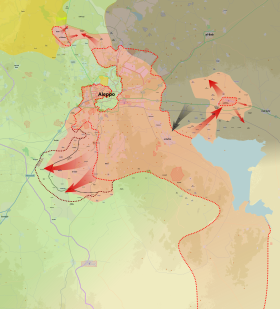
Comments
Post a Comment